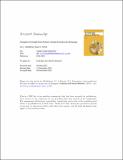Perception of strength from 3D faces is linked to facial cues of physique
Abstract
Formidability is an important cue to male intra-sexual competitiveness. While previous studies suggest strength can be accurately perceived from faces, little is known regarding the specific morphological cues that are used to form judgments of strength. Here, we used a set of three-dimensional color- and texture-standardized Caucasian faces to elucidate whether judgments of strength are based on shape cues linked to body physique. We collected facial scans of 50 men and 68 women together with measures of upper-body strength, height, weight and body composition. Upper-body strength was positively correlated with body mass index (BMI) and height. Deriving scores of the face shape associated with BMI and height, we found the face-morphological BMI score explained 27% of the variance in perceived strength. As BMI conflates muscle and fat mass, we also related absolute muscle and fat mass, separately, to actual strength and found a positive association between strength and both muscle and fat mass. We attempted to derive scores capturing the face shape associated with muscle and fat mass, controlling for each other and height. We found that facial scores of male muscle and fat both positively related to perceived strength, explaining 37% of the variance in this judgment. Our findings suggest that perceptions of strength from faces are based on facial cues to body physique. For both sexes, perceptions of strength seem to reflect overall body size or bulk, while for men additional variance was explained by separating facial cues to muscle and fat mass. The differentiation of facial shape associated with relative muscle and fat mass may have implications for the understanding of a variety of interpersonal judgments related to strength, such as dominance and leadership.
Citation
Holzleitner , I J & Perrett , D I 2016 , ' Perception of strength from 3D faces is linked to facial cues of physique ' , Evolution and Human Behavior , vol. 37 , no. 3 , pp. 217-229 . https://doi.org/10.1016/j.evolhumbehav.2015.11.004
Publication
Evolution and Human Behavior
Status
Peer reviewed
ISSN
1090-5138Type
Journal article
Collections
Items in the St Andrews Research Repository are protected by copyright, with all rights reserved, unless otherwise indicated.

